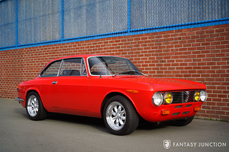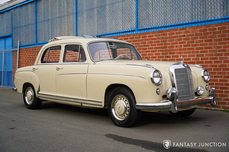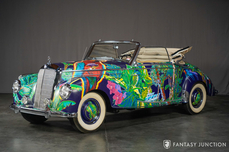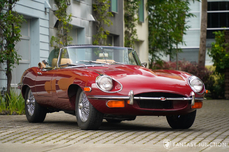Ferrari 250 California Spyder 3.0 Liter V12 no. 1079 GT 1958
General description :
1958 Ferrari 250 GT Series I Cabriolet
s/n 1079 GT, Engine no. 1079 GT
Carrozzeria Pininfarina no. 15812
Grigio Conchiglia with Red Leather Interior
The Ferrari 250 GT Series I Cabriolet has long been regarded as one of the most beautiful Ferraris of all time. The legendary collaboration between Carrozzeria Pininfarina and Ferrari has resulted in many stunning sports cars, but in the eyes of connoisseurs and enthusiasts, there is no doubt that the Series I Cabriolet is among the most eminently desirable Ferraris ever made. Often occupying a place of pride in the most significant private collections, the rarity and beauty of these cars delivers levels of satisfaction and distinction which are exceptional even in the rarefied vintage Ferrari sphere.
From 1956 to 1959, Carrozzeria Pininfarina produced just 41 of these special Cabriolets, each of which was distinctly hand made at the Pininfarina fabrication studio in Torino. Stylistically, the cars had an elegant jewel-like sophistication that distinguished them even from the stunning California Spider, of which more than twice as many were made. Californias were built by Scaglietti to their more sporting standards while PF Cabriolets were built in-house at Pininfarina to the highest possible standards. Using the 250 GT chassis, Ferrari prepared each Series I Cabriolet with the 2,952 cc Colombo V-12 engine (Tipo 128D) with three Weber 36DCL3 carburetors. Mated to the 4-speed manual gearbox and sporting independent front suspension and live rear axle, these open cars proved in period to be quite capable performers. All 41 examples were hand built to order specifically to accommodate special requests from top Ferrari clients. Definitive Series I features included the delicate razor edged taillights, muscular rear fender line, and dramatically raked windscreen, while other details varied from car to car: some had full-width bumpers, some had covered headlights, others did not.
The exceptional quality, bespoke materials, and distinctive styling were aimed specifically at Ferrari’s top customers: those eager to purchase the finest Ferrari could offer. Connolly leather, a full complement of performance instruments and warning lights, and of course an array of stunning colors and interiors were among the few selections offered to customers. And while any contemporary Ferrari was already an expensive proposition, the Pininfarina Cabriolet came at an even higher premium: an astonishing base price of $14,950 made it a full $3,000 more than the California Spider and $2,500 more than the Tour de France Berlinetta. With such pricing and exclusivity, it is unsurprising that exemplary style leaders, royalty, and other historically prominent individuals would end up comprising the roster of fortunate owners.
Today, this exceptional Cabriolet, s/n 1079 GT remains among the finest Series I examples in existence. A factory covered headlight car, 1079 GT is distinguished by a continuous chain of ownership and verified provenance, as well as a world class restoration and documented original factory mechanical components. Never rusted or damaged, the car has exceptional integrity that sets it apart even among the extraordinary company of the other Series I PF Cabriolets still in existence.
According to factory records, further supported by historian Marcel Massini as well as Classiche Red Book certification and documentation, 1079 GT was the 35th of 41 Series I Cabriolets produced. Pininfarina internally recorded the body no. 15812 to be finished in Grigio Conchiglia (Shell Gray) with striking red leather upholstery. The car was completed in October of 1958 and made its debut on the Ferrari stand at the prestigious Torino Motor Show, held at Parco Valentino from the 5th to the 16th of November 1958. In this definitive moment, the Torino Motor Show featured 1079 GT together with the first Series III Superamerica, chassis 1015 SA and a 250 GT Pininfarina Coupe, all three of which were to be memorialized in the 1958 Ferrari Yearbook. Period black and white photos depict the car with metallic paintwork, covered headlights, and full-width bumpers, all features that it retains today.
According to Massini, the car returned to the factory after being shown. At that time, the upholstery was changed from red to black and an Italian EE (“escursionisti esteri” or “foreign tourists”) temporary registration was issued to the first private owner, Mohammed bin Faisal Al Saud, prince of Saudi Arabia. Reportedly while attending college in Northern California, the prince retained his Series I Cabriolet until December 1963 when Santa Monica, CA resident Lyle B. Fox acquired the car. Fox used the car periodically around town, eventually trading it in 1972 to Chicago Ferrari dealer Joe Marchetti’s International Autos. In June 1973, the car was sold to Allen Powell of Mishawaka, Indiana, in partnership with John Delamater of Carmel, Indiana, founding member of the Ferrari Club of America. Finalizing the deal with International Autos, the car was driven home to Indiana from Chicago.
In March 1976, John Clinard of Livonia, Michigan purchased the car, beginning nearly 40 years of careful stewardship. Clinard held positions at Ford in marketing, public affairs, motor sports, and product planning, and proved to be an enthusiastic and sympathetic caretaker of 1079 GT. Mentored by noted Ferrari collector Norm Silver who also owned a Series I Cabriolet, Clinard was an avid collector and vintage racer. At the time Clinard purchased 1079 GT, the car had covered just 53,764 kilometers (approximately 33,400 miles) and was still wearing the “EE” tourist plate from 1959. In 1981, after years of enjoyable use, Mr. Clinard decided to perform a cosmetic restoration. The car was refinished in red with tan leather upholstery and completed in 1983. Clinard was the consummate conservationist when it came to 1079GT: he never started the engine unless it was to warm it to temperature fully, never drove the car on the highway to avoid stone chips, and drove the car monthly on the same route, never in inclement weather.
In 1988, Mr. Clinard moved to Southern California, subsequently engaging Rod Drew’s Francorchamps of America to perform a mechanical restoration including attention to the engine, driveline, and chassis. In 1993, 1079 GT was shown at Concours on Rodeo, Beverly Hills, where it received 2nd in class, and later that year, it was exhibited at Pebble Beach Concours d’Elegance. In 1995, it took home a 2nd place trophy at the Newport Beach Concours d’Elegance. In 2007, celebrating 50 years of the Series I Cabriolet, Mr. Clinard organized one of the largest North American gatherings, assembling a remarkable 16 of the 41 Series I Cabriolets built. Displayed on the lawn at “The Quail, a Motorsports Gathering” 1079 GT was awarded the distinguished Road & Track Trophy. Clinard kept the car a further eight years, selling it to the current owner in 2015 after 39 years of ownership.
The car’s current owner set about returning the car to its original color combination, engaging Butch Dennison to perform a cosmetic restoration during 2017. The car was stripped and repainted, its more than 50 pieces of chrome trim refinished, and the interior completely redone. Seals, lights, and lenses were replaced as required. The work was done to superlative standards with excellent attention to detail and the resulting car is stunning. Having been under the care of four previous owners, John Clinard, and the current owner, 1079 GT continues to retain its original engine (internal engine number 060 D), original gearbox (internal number 41D), and rear end (internal number 53D), all of which have been confirmed and documented by Ferrari Classiche.
The exterior finish is spectacular in all aspects. The paint is glossy and vibrant, having been refinished to the highest standards using the correct amount of metallic for the period. The color is difficult to properly characterize or depict in photos. Subtle but undeniable hues of green add an intriguing sophisticating to an otherwise classically elegant color combination. The paint exhibits consistent coverage over straight, properly fitting panels, which are nearly faultless. The finest of body details, fillets, subtle curves, and changes in surfacing are all expertly finished in both the body and paint. Doors, hood, and trunk gaps are excellent, opening and closing smoothly without issue. The chrome plating, lenses, glass, and trim are all beautifully finished and detailed to a very high standard. Lettering, emblems, and other details are refined, delightful pieces of jewelry that bring finishing touches to this truly elegant car. The perfectly laced Borrani wire wheels are intricately detailed and accented by chrome plated knockoffs which show a bit of thinning to the finish but are otherwise in excellent shape. Two cleverly concealed large fog lamps accent the distinctive egg crate grille. This feature, coupled with the covered headlights and wide hood scoop, add a bit of racing flavor to the look of the car. The stance, elegantly dipped belt line, and stately presence are remarkably modern and beautifully timeless.
The interior is beautifully bespoke with rich, taut red leather, perfectly trimmed with correct piping and pleating, accented by factory correct carpeting in black. Finishes throughout are exquisite including the correctly finished black crinkle dashboard displaying an elegant array of performance gauges, each one a delightful artifact of 1950s era artistry, punctuated by delicate warning lights between each of the smaller five companion gauges. The warmly hued wood-rimmed Nardi steering wheel is accented with polished aluminum spokes and emblazoned with the traditional yellow and black center and prancing horse. The red and black interior creates a handsome contrast against the elegant exterior.
Under the hood, the matching numbers V12 engine has been comprehensively restored and correctly detailed using correct finishes and accessories, as well as properly treated hardware. Considerable attention was paid to correctness and authenticity of the engine’s presentation during the recent restoration, down to the correct Fram oil filtration system. Often over restored, cars of this caliber will feature components that appear accurate but are over-zealously finished. Here, particular care has been given to each component, allowing for patina, originality, and respectful refinishing, presented in harmony with the provenance of this spectacular car. The trunk has been nicely finished with black carpeting, displaying the spare Borrani wire wheel and tire in the proper upper trunk shelf. Here too, as with the rest of the car, one can admire the attention to detail on the underside of the trunk lid, the detailing under the hood, the beautifully finished door jambs and latching hardware, correct fasteners, and trim work. Further inspection of the undercarriage reveals a properly maintained but never restored chassis with correct finishes, and attention to detail consistent with the history, restoration, and provenance of this fine car.
The car starts immediately settling into a wonderful idle, properly set to reveal gently muffled V12 sounds intended for Ferrari road cars. Everything about the car works in harmony, from the smooth shifter to the easily engaged clutch, one is surprisingly pleased by the drivability of this expertly sorted example. Ferrari experts who come in contact with 1079GT consistently comment on the wonderfully dialed and unmolested mechanical character of the car. Cruising at speed, it is easy to see how these cars must have immediately delighted their first owners and each successive caretaker over time. Surely the four decades of singular ownership associated with 1079 GT are testimony to the satisfying performance this car delivered to John Clinard year after year.
This exceptional Ferrari Series I Cabriolet comes with a tool roll, keys, and a rare factory brochure, along with a host of period promotional material. A copy of the 1958 Ferrari Yearbook is included along with correspondences between John Clinard and Pininfarina, as well as a selection of service and restoration records, a detailed mileage log, copies of the factory build sheets, Ferrari Classiche certificate with Red Book, and a complete history report produced by Marcel Massini.
The magnificent Ferrari 250 GT Series I Cabriolet has always been an unrivaled object of exceptional beauty and sophistication. An integral part of establishing Pininfarina and Ferrari’s history, each of these fine cars have long captivated the most distinguished connoisseurs with their sophistication, beauty, and technical prowess. 1079 GT is an exceptional no-stories covered headlight Cabriolet, not only because of its exhibition at the Turin Auto Show and early royal ownership, but because of its superlative integrity. Always enthusiastically owned and never allowed to fall into disrepair, it has retained all its original mechanical components and coupled with its lovely original color combination, exemplifies the elegance and excitement of the brief but magnificent coachbuilt Ferrari era.
http://fantasyjunction.com/cars/2133-Ferrari-250%20GT%20Pinin%20Farina%20Series%20I%20Cabriolet-3.0%20Liter%20V12
1958 Ferrari 250 California Spyder 3.0 Liter V12 no. 1079 GT is listed sold on ClassicDigest in Emeryville by Fantasy Junction for Not priced.
Car Facts
Car type : Car Make : Ferrari Model : 250 California Spyder Model Version : 3.0 Liter V12 no. 1079 GT Engine size : 3.0 Model Year : 1958 Location : Emeryville
Sold
Seller Information
Sold
Other cars listed for sale by this dealer
About Ferrari
The first Ferrari road car was the 125 S introduced in 1947 and powered by a 1.5 L V12 engine, right? Well it's not quite that simple, Ferrari did in fact produce e Tipo 815, in 1940. Tipo 815 was designed by ex-Alfa Romeo engineers Alberto Massimino and Vittorio Bellentani and by Enrico Nardi under Enzo's company but legal issues with the former associate Alfa Romeo prevented Ferrari from launching the Ferrari marque at that point.
Enzo did produce a series of fine road cars in the 50's and 60's but they were merely to finance his true passion racing, wheather GT/Sports car or Grand Prix. The 50's saw the birth of Ferrari's most memorable cars, 250 GTB (tour de France) 250 Testa Rossa, 250 GT swb just to name a few.
Under the surface tension was growing though. In November 1961 long-time sales manager Girolamo Gardini made an ultimatum to Enzo: if tensions continued, he would leave the company. As a result, Gardini was ousted, as well as Scuderia Ferrari manager Romolo Tavoni, chief engineer Carlo Chiti, experimental sports car development chief Giotto Bizzarrini, and a number of others who stood by them.
Without Chiti and Bizzarrini the development of what was to become the most quintessential Ferrari and today the world's most expensive car, 250 GTO, was at a pivoting point. 250 GTO project was saved by a young engineer Mauro Forghieri and long-time racing bodyman Sergio Scaglietti who stepped in and took over the program with known results.
In addition to 250 GTO, Ferrari launced such master pieces as 250 LM, 250P, 275 GTB, 365 GTB/4 "Daytona" during the the 60's
By the late 60's Ferrari's prototypes' success came to a sudden halt by a new competitor, GT40. Ford turned to Lola to produce a Ferrari beating long distance racer after Enzo had cut the deal off with Henry Ford II making the latter absolutely boil with fury. The collaboration between Ford and Lola created the mighty Ford GT40 that gave Ferrari some heavy hits in Le Mans 24 to come.
By the end of the 60's FIAT purchased 50% of the company, starting a development that has led to a new mass-produced era of Ferraris.
Whether you are selling or looking for a classic Ferrari www.classicdigest.com is the place to check out.






